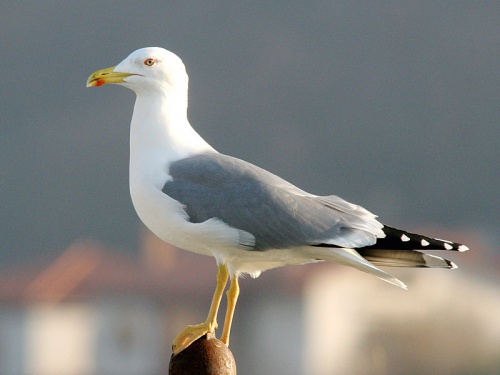- Larus michahellis
Identification
52–58 cm (20½-22¾ in)
Adult
- Grey back
- Black wing tips with few white spots
- Red spot on the bill
- Red eye-ring
First-year
- Dark bill and eyes
- Pinky-grey legs
- Blackish flight feathers
- Black band on the tail
Second winter
- Almost adult plumage
- Retaining feather patterning on the wing coverts
- Black bill tips
- Dark eyes
- Pale yellow legs
Similar Species
ID discussion on how to distinguish Caspian (L. cachinnans) and Yellow-legged Gull (L. michahellis and L. m. atlantis).
Variation
Western birds (subspecies atlantis) has a darker mantle than more easterly birds.
Distribution
Taxonomy
Caspian Gull is included by some authorities in Yellow-legged Gull. The scientific name for the species would then be Larus cachinnans.
Subspecies
There are 2 subspecies[1]:
- L. m. michahellis
- Breeds in the Mediterranean
- L. m. atlantis
- Breeds on Atlantic shores adjacent to the Mediterranean.
Habitat
Fields and coasts.
Behaviour
Diet
They are scavengers and also rob other birds of their catches. Their varied diet consists of fish, invertebrates, mammals, rodents, birds eggs and chicks. Also refuse and offal.
Breeding
They breed in colonies. The nest is a mound of vegetation built on the ground or on cliff ledges. The clutch consists of 3 eggs which are incubated for 27-31 days; the young fledge after 35-40 days.
References
- Clements, J. F., T. S. Schulenberg, M. J. Iliff, T. A. Fredericks, J. A. Gerbracht, D. Lepage, S. M. Billerman, B. L. Sullivan, and C. L. Wood. 2022. The eBird/Clements checklist of Birds of the World: v2022. Downloaded from https://www.birds.cornell.edu/clementschecklist/download/
- Dickinson, EC, ed. 2003. The Howard and Moore Complete Checklist of the Birds of the World. 3rd ed., with updates to October 2008 (Corrigenda 8). Princeton: Princeton Univ. Press. ISBN 978-0691117010
- Sibley, CG and BL Monroe. 1996. Birds of the World, on diskette, Windows version 2.0. Charles G. Sibley, Santa Rosa, CA, USA.
- Handbook of the Birds of the World Alive (retrieved November 2015)
Recommended Citation
- BirdForum Opus contributors. (2025) Yellow-legged Gull. In: BirdForum, the forum for wild birds and birding. Retrieved 11 May 2025 from https://www.birdforum.net/opus/Yellow-legged_Gull
External Links
GSearch checked for 2020 platform.1






